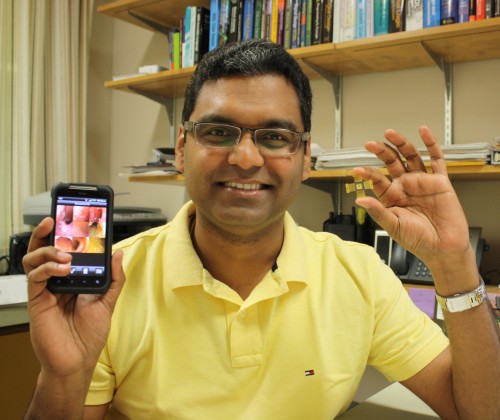Inside view: Improving endoscopy imaging
Khan Wahid wants to help your doctor see a whole other side of you.
By Michael Robin The associate professor of electrical and computer engineering and his team are developing new patent-pending technology for video endoscopy capsules.
The associate professor of electrical and computer engineering and his team are developing new patent-pending technology for video endoscopy capsules.
When it comes to getting a good look at your ailing innards, there are few tools more useful than these high-tech pills, which contain a video camera, battery, light-emitting diode (LED) and a transmitter, explained Wahid. They are especially valuable for diagnosing causes of bleeding or abdominal pain like Crohn's disease, peptic ulcers or colorectal cancer.
"Doctors are not satisfied with the current image quality from endoscopy capsules. We are working to improve the technology in several ways, which will lead to more consistent, accurate diagnosis," Wahid said.
One of the problems with endoscopy capsules, which measure only 11 millimetres by 26 millimetres, is they can "jump" areas of tissue without imaging them, so doctors do not get a continuous picture, he explained. To meet the challenge, Wahid's team has developed algorithms that much more efficiently capture and process images, decreasing the workload of the onboard computer chip while increasing quality and the frame rate to provide images more frequently. This helps extend battery life, ensuring the capsule remains in operation throughout its eight-to-10-hour journey. The result is technology that allows for a more complete, real-time diagnosis of gastrointestinal diseases, and may make it possible to add features to future endoscopy capsules.
Wahid and his team are also looking at the rather intrusive data recorder worn by patients after swallowing the capsule. Their solution is a mobile device application and a SIM card-sized adapter that transmits information directly to the patient's smartphone.
With two patents pending, the U of S Industry Liaison Office (ILO) is evaluating ways of taking the technology to market, whether it be through licensing or a start-up enterprise. Research work so far has been supported by Natural Sciences and Engineering Research Council of Canada and Canada Foundation for Innovation, and the ILO as has provided additional funding through their Forge Ahead Fund for Wahid and his team to develop a prototype.

